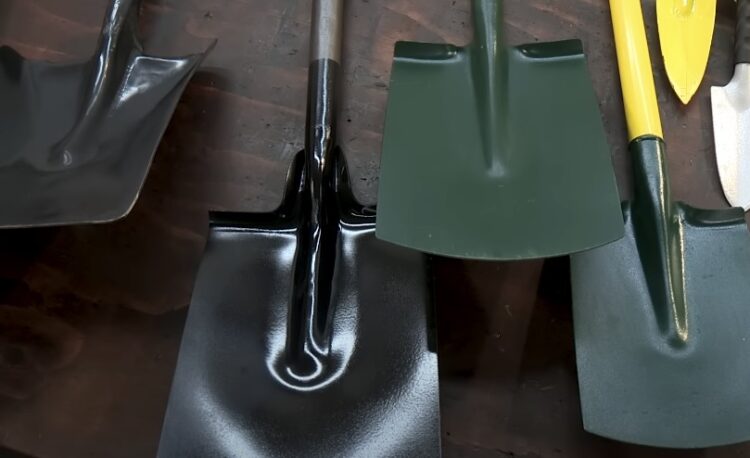What are shovels, and why are they so crucial in agriculture? A shovel, at its core, is a tool for lifting, moving, and digging. It’s a farmer’s trusty companion, a silent ally in the fight against weeds, and a vital instrument for soil management. It’s almost as if the soil and the shovel have a conversation, with the shovel understanding precisely what the soil needs.
Types of Shovels and Their Uses
Whether you’re preparing the soil, planting seeds, weeding, or harvesting, choosing the right type of shovel is crucial for efficient and effective work. Let’s explore different types of shovels and their uses, providing you with the knowledge to select the perfect tool for your gardening needs.
Flat Shovels
Their broad, flat blades, occasionally tapering to a point, are a defining feature. They work wonders when you need to move loose materials like mulch, sand, or dirt. You may scoop and transport things efficiently on the flat surface. Features that are essential for flat shovels are:
| Key Features | Description |
|---|---|
| Blade Shape | Wide and flat, with a slight curvature. |
| Ideal for | Shoveling loose materials like soil, gravel, or compost. |
| Use Cases | Digging trenches, filling holes, leveling surfaces. |
| Not Suitable for | Cutting through dense roots or tough turf. |
Spades
On the other hand, their blades are sharper and more pointy than flat shovels’. They are great at cutting through tough surfaces and are mostly used for digging, trimming edges, and cutting grass. Here are the most important things about spades:
| Key Features | Description |
|---|---|
| Blade Shape | Pointed and sharpened, ideal for cutting through tough materials. |
| Ideal for | Digging holes, edging, cutting through roots or turf. |
| Use Cases | Creating planting holes, shaping borders, and trenching. |
| Not Suitable for | Moving loose materials efficiently like flat shovels. |
Soil Preparation with a Shovel
Soil preparation is a critical step in gardening and agriculture. It involves getting the soil ready for planting by improving its structure, aeration, and nutrient content. Shovels play a vital role in this process by turning the soil effectively. Here’s why soil turning is essential:
- Aerating the Soil: When you turn the soil using a shovel, you break up compacted layers and allow oxygen to penetrate deep into the ground. This promotes healthy root growth and improves overall soil structure;
- Mixing Amendments: Shovels enable you to incorporate organic matter, compost, or fertilizers into the soil evenly. This ensures that plants receive essential nutrients for robust growth;
- Removing Debris: Soil turning helps in removing rocks, weeds, and unwanted debris, creating a clean and fertile canvas for planting.
Proper soil preparation sets the stage for a successful garden or crop. The choice of shovel depends on the specific tasks involved; flat shovels are suitable for turning and mixing loose soil, while spades are excellent for breaking compacted soil and removing turf.
Planting and Transplanting

Planting is a delicate process that requires precision and care. Shovels are not just for digging holes but also for creating suitable environments for seeds and transplants. Here’s how shovels assist in planting:
- Digging Planting Holes: Shovels are used to dig holes of the right depth and size for different plants. Proper hole dimensions ensure that the roots have enough space to grow and access moisture and nutrients;
- Loosening Soil: Before planting, the soil around the hole is loosened with a shovel to facilitate root penetration and water absorption;
- Transplanting: Shovels can be used to carefully lift and transplant seedlings or mature plants without causing damage to their roots or stems.
Selecting the appropriate shovel for planting depends on the size and depth of the holes needed, as well as the type of soil you are working with.
Weeding and Maintenance
Maintaining a weed-free garden is an ongoing battle, and shovels serve as valuable allies in this endeavor. Here’s how shovels are used for weeding and general garden maintenance:
- Weed Removal: Shovels with flat blades are employed to dig out weeds from the root, ensuring they do not grow back quickly;
- Edging: Spades are excellent for creating clean edges around flower beds or garden borders, preventing invasive grass or weeds from encroaching;
- Digging and Cultivating: Shovels are used to turn the soil between rows of plants, allowing air and water to reach the roots while disrupting weed growth.
Regular maintenance tasks like weeding and edging are essential for keeping your garden healthy and visually appealing.
Harvesting Techniques

When the time comes to reap the rewards of your hard work, shovels are again pressed into service. Harvesting root crops, such as potatoes and carrots, can be made more manageable with the right technique and shovel selection:
- Digging Up Roots: A shovel’s sharp edge is used to gently unearth root crops from the soil, preventing damage to the harvest;
- Loosening Soil: Before harvesting, soil around the crop is loosened to make it easier to extract the roots;
- Handling Delicate Roots: Shovels are employed with care to avoid bruising or breaking the delicate roots of the crops.
Irrigation and Water Management
One of the fundamental aspects of successful agriculture is efficient water management. Water is a precious resource in farming, and ensuring its proper distribution to crops is essential for optimal growth. Shovels come into play as versatile tools for creating small trenches or furrows in the soil. These trenches serve as channels for directing water towards plant roots, preventing wastage through runoff and ensuring that plants receive a consistent supply of moisture.
Key Benefits of Using Shovels in Water Management:
- Precise Irrigation: Shovels allow farmers to control the depth and layout of trenches, ensuring that water reaches the root zone of plants, where it is needed the most;
- Reduced Water Waste: By preventing water from spreading indiscriminately across the field, shovels minimize wastage and contribute to water conservation efforts;
- Improved Soil Structure: The act of digging trenches with shovels can also help in loosening compacted soil, enhancing its ability to absorb and retain water.
Shovels in Organic Farming
In the realm of organic farming, where the use of heavy machinery is often limited due to the emphasis on natural and sustainable practices, shovels emerge as indispensable tools. Organic farmers prioritize maintaining the natural balance of the soil, and shovels align perfectly with this objective.
Here are some key roles shovels play in organic farming:
- Weed Control: Shovels can be used to manually remove weeds from the field, avoiding the need for chemical herbicides;
- Composting: Shovels aid in the incorporation of organic matter and compost into the soil, enriching its fertility naturally;
- Crop Rotation: Organic farming often involves crop rotation to maintain soil health, and shovels are used for preparing the soil for different crops.
Advanced Shovel Techniques
Experienced farmers often employ advanced techniques to maximize the effectiveness of shovels in various farming tasks. These techniques require skill and precision but can significantly enhance the outcomes of manual labor.
Some advanced shovel techniques include:
- Double-Digging: This technique involves digging a deep trench and then refilling it with layers of compost and topsoil, creating a nutrient-rich planting bed;
- Trenching for Drainage: Shovels are used to create drainage trenches, preventing waterlogging in fields and ensuring optimal root health;
- Terracing: Shovels are used to build terraces on sloped terrain, preventing soil erosion and making farming on hillsides more manageable.
Innovations in Shovel Design

The future of shovels is marked by ongoing innovations in design and materials. Manufacturers are continuously striving to improve the ergonomics, durability, and efficiency of these essential farming tools.
Some noteworthy innovations in shovel design include:
- Ergonomic Handles: Shovels with ergonomic handles reduce strain on the user’s hands and back, making prolonged use more comfortable;
- Lightweight Materials: Shovels made from lightweight yet sturdy materials like fiberglass and carbon fiber are becoming popular, reducing fatigue during use;
- Improved Blade Materials: Advances in metallurgy have led to the development of shovel blades that are more resistant to wear and corrosion, increasing their longevity;
- Specialized Shovel Shapes: Shovels with specialized shapes, such as square-edged blades for cutting roots, are designed for specific tasks, enhancing their versatility.
Conclusion
Shovels are the unsung heroes of modern agriculture, serving as versatile tools that play a crucial role in soil preparation, planting, weeding, harvesting, and irrigation management. Their continued evolution in design and materials ensures their enduring significance in farming practices.
FAQ
A shovel is used for soil preparation, planting, weeding, harvesting, and irrigation management.
In organic farming, shovels help maintain soil health and structure without the need for heavy machinery.
Flat shovels and spades are the most common, each serving a specific purpose in farming.
Regular cleaning, sharpening the edge, and storing it in a dry place will keep your shovel in good condition.
Yes, there are shovels designed with ergonomic handles and lightweight materials to reduce strain during use.

